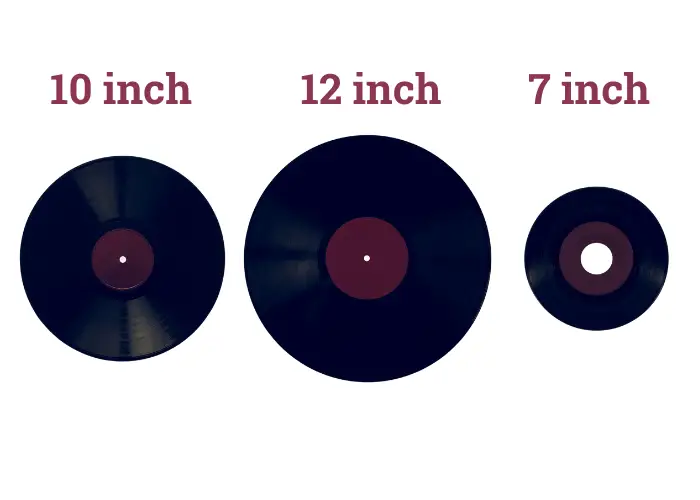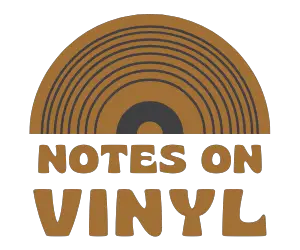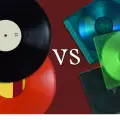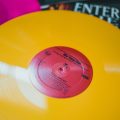Familiarising ourselves with the various ins and outs of the vinyl record collecting community can be really overwhelming, especially to newcomers! All these glyphs and numbers and record sizes, and so little time!
If you, like we all once did at some point, are looking for a handy and no nonsense guide to the various vinyl record sizes, then look no further. Today, we will elucidate for you the three main record sizes, the speeds at which they are usually played, and a few other interesting titbits to tell your newfound record collecting friends!
Table of Contents
- What Vinyl Record Sizes Are There
- What Vinyl Record Speeds Are There
- Common Vinyl Record Sizes With Their Typical Speeds and Uses
- 12 Inch Records
- 10 Inch Records
- 7 Inch Records
- Final Tones
- FAQs Record Sizes
What Vinyl Record Sizes Are There
Vinyl records come in various sizes, each designed for different amounts of music or types of recordings. Here are the primary sizes you’ll encounter:
7-inch Records. These records are typically played at 45 RPM (Revolutions Per Minute) and are known as singles. They usually contain one song per side and are often used for individual tracks or singles.
10-inch Records. This size can be found at both 78 RPM (historically) and 33 1/3 RPM. The 10-inch records at 78 RPM were common before the mid-20th century for single-track recordings. The 33 1/3 RPM versions are less common and might be used for shorter albums or EPs (Extended Plays).
12-inch Records. These are the standard size for full-length LPs (Long Plays) and are usually played at 33 1/3 RPM. They can hold around 15 to 22 minutes of music per side. The 12-inch format at 45 RPM is also used for maxi-singles, providing higher audio quality for single tracks or extended versions.
Each size and speed combination has its own characteristics and uses, influencing audio quality, the amount of music that can be stored, and the type of content typically found on the record.
What Vinyl Record Speeds Are There
Vinyl records are primarily available in three speeds, measured in revolutions per minute (RPM). Each speed is associated with specific record sizes and has its own historical and practical reasons. Here are the different vinyl record speeds:
33 1/3 RPM. This speed is used for LP (Long Play) records, which are typically 12 inches in diameter. It’s the standard speed for full albums because it allows for more music to be stored on each side of the record—approximately 15 to 22 minutes per side.
45 RPM. This speed is commonly used for 7-inch records, known as singles, which usually feature one song per side. It’s also used for 12-inch records intended for higher-quality audio and extended play versions of singles, allowing for about 7 to 15 minutes of music per side. The 45 RPM records provide better fidelity than 33 1/3 RPM records because the faster speed allows for higher frequency reproduction and better sound clarity.
78 RPM. These were the standard before the introduction of the 33 1/3 and 45 RPM formats, primarily used with 10-inch records, though sizes could vary. 78 RPM records were made of shellac instead of vinyl and could hold about 3 to 5 minutes of music per side. This speed has largely been phased out with the advent of newer formats but remains a significant part of phonographic history.
Each speed serves different purposes and has contributed to the way music is recorded, distributed, and enjoyed.
Common Vinyl Record Sizes With Their Typical Speeds and Uses
| Record Size | Speed (RPM) | Typical Use | Music Duration per Side |
| 7-inch | 45 | Singles | Up to 5 minutes |
| 10-inch | 78 | Early single-track recordings | Varies, but short |
| 10-inch | 33 1/3 | EPs, shorter albums | Up to 15 minutes |
| 12-inch | 33 1/3 | LPs (full albums) | 15 to 22 minutes |
| 12-inch | 45 | Maxi-singles, high-quality audio | 7 to 15 minutes |
12 Inch Records
Of the three most popular record types, the 12 inch record will more often than not house a recording of an entire album, typically one half allotted per side of the physical disc. It is more often the case, also, that these albums will be played at 33 1/3 rpm, as this means there is more space on the record to contain the music which is being released in this longer form, able as a 12 inch record is to hold roughly 15 to 22 minutes of music per side.
12 inch discs and 33 1/3 rpm playback speeds were relative latecomers to the party, arriving at a time when radios were the primary source of musical and listening entertainment for most consumers. Thus, the 33 1/3 RPM 12 inch record disc format didn’t exactly have the smoothest start, though they were and still are relatively unparalleled, if only for being so effective at offering longer playback times on similar sizes of discs.

By 1948, after a less than welcoming birth into the world, Columbia records began advertising to the masses, heralding the 33 1/3 RPM record as a breakthrough in audio technology, able as it was to hold whole classical performance and symphonies on just one side of a 12-inch disc without the need to interrupt the listening experience to flip the disc.
Advertising it in this way, assimilating this format with the music of the western classical elite, instantly lent the format new standing in the music community, being able to hold what is considered by many to be the pinnacle of artistic achievement in the musical sphere, on this of all record sizes.
10 Inch Records
This will be one of the rarer record sizes that you will encounter in the wild, excusing some novelty or limited edition records, and one of those types of records that I can safely say you won’t be seeing as much of as its 12 inch and 7 inch brethren.
In being one of the most, if not the most, liminal of record sizes, many disregard its uses, simply seeing it as not very useful at all in fact. With a run time of 12 to 15 minutes at 33 1/3 rpm and 9 to 12 minutes at 45 rpm, there are no doubts as to the liminality of the medium. However, in an age where attention spans are getting shorter and shorter, this is perhaps not a bad thing, and ought to be capitalised on more.
The inventor of the Gramophone record, Emile Berliner, created records that were played between 70 and 80 RPM, a precedent which was followed pretty strictly to the point where 78 RPM became the industry standard throughout the western world by 1925. While the sizes of these original 78 RPM records vary, they were typically rendered on 10 inch records so as to accommodate for the shorter playback time, eventually becoming the standard size for records played at this speed.
This soon became a fairly unpopular form for music to be released upon, not just for the less than adequate playback time offered. Thus, 78 RPM records are rarely if ever produced anymore, and even older record players and turntables are scarcely found with a setting to play them, meaning that if they were produced they as a medium wouldn’t have much of an audience, despite any audiophilic claims of better fidelity.
In turn, there are less and less 10 inch records produced these days, after the decline in popularity of the 78 rpm speed of record disc playback.
7 Inch Records
Last, smallest, but by no means the least powerful, is the 7 inch record! Certainly, the smallest of the more common vinyl record sizes, this lack in size ought not translate to an overall lack of presence, for they can be found everywhere.
These record sizes are typically played at 45 rpm for the sake of audio quality; they are the perfect size for holding a single song on each side (depending on the length of the songs in question of course), able to capture 4 to 6 minutes on each side, with the run time increasing to around 7 minutes if played at 33 1/3 rpm. Therefore, they are often called singles instead, hence where the term gets it name in the first place.
In producing smaller discs in the first place, the aim seems to have been to provide music listeners with a more transportable medium upon which to print more high-quality versions of album singles. Seeing as the album didn’t even really become a seriously considered medium until the 1960s – other than in collating a bunch of unrelated singles – this medium rapidly became the currency for the exchange of popular music, able as it was to contain in a smaller format the content from an upcoming release.
Since the radio was still the go-to format for the discovery and exploration of all things popular and musical in this period, many, if not all, popular radio hits of this period were, in fact, stored on 45 RPM 7-inch vinyl record sizes. Used in this way, the discs were only really, at a push, able to contain one or two songs per side, so the records quickly acquired the name ‘singles’, which has since become the go-to term for the naming of a song that is released outside the bounds of a longer form release.
Final Tones
So, there you have it! Hopefully, this concise yet comprehensive guide through three main record sizes has been of some use to you in your record-collecting journey and in familiarising yourself with the various ins and outs of the community and the jargon!
FAQs Record Sizes
What are the 3 sizes of vinyl records?
There are three more common vinyl record sizes. First, and arguably most popular on this side of the fin de siècle, is the 12 inch record, which typically plays at 33 1/3 rpm, housing more often than not whole albums on two sides or more. Next, as we decrease our search sequentially in diameter, comes the 10 inch record, far less common and originally geared towards playing 78 rpm records in the earlier days of vinyl recording technology. Finally, of the more common record sizes, we have the 7 inch single, which once reigned supreme, geared more towards holding a couple of songs in a portable medium.
What is the difference between 33 45 and 78 records?
The central difference lies in the speed at which they are supposed to be played. A 33 1/3 record will need to be played at 33 1/3 rpm (revolutions per minute) in order to sound as close to intended as possible to the original recording. The same goes for 45 rpm records and the far less common 78 rpm record. By all means, play a disc at a different speed to that which is intended. It can, in fact, be very enjoyable and interesting to experiment in this way. This, however, will not sound as the composer, musicians, producer, etc. intended it to.
What size is a 45 record?
More often than not, a record that requires being played at 45 rpm in order to sound as intended will be on 7 inch record sizes. The shorter playback time, as a result of the increased playback speed, makes this medium perfect for the housing of one or two single tracks per side, depending on their respective length. There is, however, an increasing trend of late to master albums at half speed. This has many benefits, most of which pertain to audio fidelity. Records mastered at half speed, typically on 12 inch discs, will require playback at 45 rpm instead of the usual 33 1/3 rpm of 12 inch record sizes.
What is the size of a 33 record?
More often than not, a record that requires being played at 33 1/3 rpm in order to sound as intended will be on 12 inch record sizes. The longer playback time, as a result of the decreased playback speed, makes this medium perfect for the housing of several tracks per side, depending on their respective length, even catering for longer tracks, or more symphonic or cinematic music (see Godspeed You! Black Emperor). There is, however, a tradition, especially in electronic music circles, to release singles on 12 inch record sizes. These longer extended cuts of singles are perfect for the medium, given more space to develop, but with the option of higher fidelity owing to the higher playback speed.





